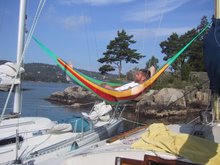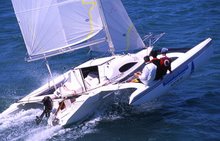The Telstar has a bow cleat that snags every line within ten feet, so I was looking for a solution to this on the new boat. Even though the cleat is the specified size, I had to expand the prescribed HD insert in the fore deck to give proper support for this one (to have in mind for new builders).
The good thing with this cleat is it retracts when not in use, to avoid the above mentioned problem, and sore toes. Also visible is the almost flush anchor locker hatch fitting.
The jib traveller will consist of a Ronstan series 19 track on the carbon traveller support, with a double set of small shacle cars
(RC 11902), each carrying a Ronstan
Orbit 40 block. The sheet will be led from one cabin top winch via a block lashed to the deck, trough the first car block, the
Series 55 OrbitBlock at the clew and the mirrored route on the other side. This will give a 2:1 purchase and the possibility of furling the jib with sheets untouched. Also, trimming the jib will be possible from any side winch (freeing the other one for screecher or spin). The traveller will be placed as low and close to the mast as possible to maximize sail area, and will pass between the mast step and the raised daggerboard.
I made up blocks of light foam as moulds for the traveller brackets and laminated them in situ.
In situ jib track support brackets moulding. The lay up consisting of one layer 400gsm DB - three layers 240gsm UD - one layer 400 gsm BD - three layers 240 gsm UD - one layer 400 gsm BD.
The brackets will be bolted trough deck, in order to accomodate mast step and daggerboard removal. The mast rotators will be attached underneath the brackets.
Side view.
The fore deck area from tack (in the hole) to clew positions. In the background the heating cabinet I put up for the rudder moulds, they have been repaired and after cure they will receive last sanding finish and high performance mould wax.
A look into the heating cabinet...
One mould half ready for final preparations.
I also made a sturdy raised frame/flange for the aft cabin hatch. Hatches leak, there is as I understand a universal understanding of this fact, but the leaks can be minimized by for instance making sure larger amounts of water will not collect at the seal. Also, I really maximized the cut out for this hatch with regards to the limitations provided by the designer, so I wanted to at least strengthen the perimeter of the cut out.
20 mm raised flange from HD foam and 400 gsm BD carbon.


































